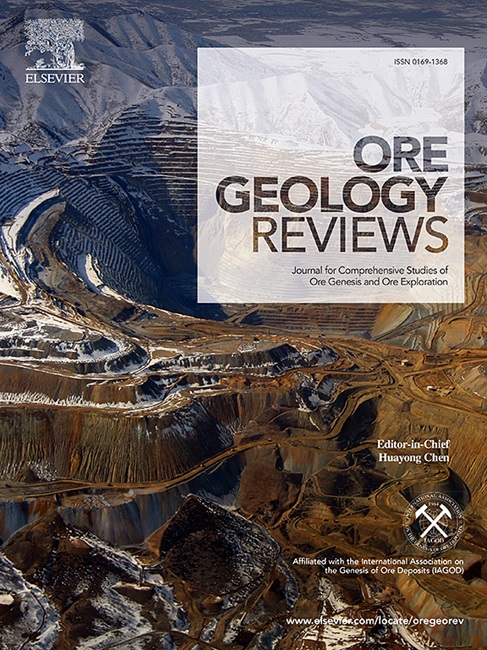A DFT study on mechanisms of indium absorption in sphalerite (100), (110), and (111) surfaces: Implications for critical metal mineralization
IF 3.2
2区 地球科学
Q1 GEOLOGY
引用次数: 0
Abstract
As an important critical metal, indium (In) enters sphalerite through isomorphous substitution of Zn. Regarding crystallography and chemical kinetics, In adsorption in sphalerite surfaces is a key factor controlling its occurrence in sphalerite, because this is a prerequisite for triggering the substitution process. Nevertheless, mechanisms of In absorption in sphalerite surfaces remain ambiguous, which hinders our understanding of the physicochemical conditions for forming In-bearing sphalerite. Thus, we employed the first-principles calculations method based on density functional theory to investigate the structural characteristics of the three primary sphalerite surfaces, namely (100), (110), and (111), under In adsorption. As an illustrating purpose, we addressed the substitution process of In3+ + Cu+ → 2Zn2+, one of the most common and important substitution mechanisms for forming In-bearing sphalerite in natural mineralization. We calculated the adsorption energy and electronic structure of In3+ and In3+–Cu+ adsorption in the sphalerite (100), (110), and (111) surfaces, respectively. The results suggest that the (111) surface is notably the most conducive to In entering sphalerite, attributed to the low adsorption energy for both In3+ and In3+–Cu+ onto it. Cu+ enhances In3+ adsorption in the sphalerite surfaces due to it significantly reduces the adsorption energy. The considerable differences in the electronic structures of the three sphalerite surfaces restrict the charge transfer between In3+ and other atoms present, ultimately controlling their In adsorption behaviors. This analysis sheds light on the variations in the In3+ adsorption processes on the sphalerite (100), (110), and (111) surfaces at an atomic level. It offers a deep understanding of the mechanisms driving the formation of In-bearing sphalerite, especially in the context of critical metal mineralization.

求助全文
约1分钟内获得全文
求助全文
来源期刊

Ore Geology Reviews
地学-地质学
CiteScore
6.50
自引率
27.30%
发文量
546
审稿时长
22.9 weeks
期刊介绍:
Ore Geology Reviews aims to familiarize all earth scientists with recent advances in a number of interconnected disciplines related to the study of, and search for, ore deposits. The reviews range from brief to longer contributions, but the journal preferentially publishes manuscripts that fill the niche between the commonly shorter journal articles and the comprehensive book coverages, and thus has a special appeal to many authors and readers.
 求助内容:
求助内容: 应助结果提醒方式:
应助结果提醒方式:


